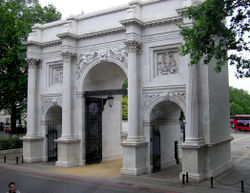Marble Arch
51°30′47″N 0°9′32″W / 51.51306°N 0.15889°W



Marble Arch is a white Carrara marble monument near Speakers' Corner in Hyde Park, at the western end of Oxford Street in London, England, near the tube station of the same name. The name Marble Arch also refers to the locality of west London where the arch is situated, particularly the upper half of Edgware Road. Historically, only members of the royal family and the King's Troop, Royal Horse Artillery were allowed to pass through the arch[citation needed].
History
In 1828, John Nash designed the arch based on the triumphal arch of Constantine in Rome. It was originally erected on The Mall as a gateway to the new Buckingham Palace (rebuilt by Nash from the former Buckingham House).
In 1851, the arch was moved to its present location during the building of the east front of the Palace. (A popular story says that the arch was moved because it was too narrow for the Queen's state coach to pass through, but in fact the Gold State Coach passed under it during Elizabeth II's Coronation in 1953[1].)
It has been speculated that the arch might be moved to Hyde Park, or to some other location [2].
Design
There are three small rooms inside that were used as a police station until 1950, first for the royal constables of the Park and later the Metropolitan Police. One policeman stationed there during the early 1860s was Samuel Parkes who won the Victoria Cross in the Charge of the Light Brigade in 1854.
Some sculptures intended for the arch ended up on the façade of the National Gallery due to Nash's financial problems. In particular are those high up on the east façade, opposite the Edith Cavell memorial (Britannia) and above the old main entrance under the portico. These last two were originally intended to represent the campaigns of the Duke of Wellington, these sculptures include reclining personfications of Europe and Asia/India, with a blank roundel in between. Had the arch been completed as planned, the Duke of Wellington's face would have been depicted in the roundel.
Location
The nearest London Underground station is Marble Arch, on the Central Line.
The area around the arch forms a major road junction connecting Oxford Street to the east, Park Lane (A4202) to the south, Bayswater Road (A402) to the west, and Edgware Road (A5) to the north-west. The short road to the north of the arch is also known as Marble Arch.
The area once was home to the largest cinema screen in London in the Odeon Marble Arch. The screen was originally over 75 feet (23 m) wide. The Odeon showcased 70 mm films in a large circle and stalls auditorium. The cinema was converted into a mini-plex in 1997.
The area is also near to the largest Marks & Spencer store in the United Kingdom.
The arch stands close to the site of the Tyburn gallows (sometimes called 'Tyburn Tree'), a place of public execution from 1388 until 1793.
Image gallery
-
Europe
-
Asia/India
-
Britannia, now Minerva, patroness of the arts
References
External links
- 1828 architecture
- Monuments and memorials in London
- Regency London
- Buildings and structures in Westminster
- Triumphal arches in the United Kingdom
- Road junctions in London
- Streets in Westminster
- Grade I listed buildings in London
- Grade I listed monuments and memorials
- Visitor attractions in London
- Relocated buildings and structures



